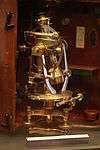Cooke, Troughton & Simms
Cooke, Troughton & Simms was a British instrument-making firm formed in York in 1922 by the merger of T. Cooke & Sons and Troughton & Simms.
 Cooke, Troughton & Simms Theodolite | |
| Subsidiary of Vickers | |
| Industry | Scientific instruments |
| Fate | Ceased teading after becoming a part of Vickers Instruments |
| Predecessors | T. Cooke & Sons Troughton & Simms |
| Founded | 1922 in York, England, United Kingdom |
| Defunct | 1963 |
| Products | Microscopes, theodolites |
Number of employees | 3300 (during World War II) |
Origins
Thomas Cooke set up a business in York in 1837 making astronomical telescopes. One early notable instrument was a 4.5 inch equatorial refractor which would have been exceptional at the time. In 1851 Cooke built a 7.25 inch equatorial telescope. Cooke made the optical elements himself for both these instruments. Thomas Cooke built a reputation for high quality optics and, as well as smaller instruments, supplied large instruments to observatories around the world.[1]
From the outset in 1826 and earlier Troughton ans Simms of London excelled in the high precision work of dividing circles and so provided many observatories with large transit instruments and supplied national surveys such as the Ordnance Survey, with large transit theodolites.[2]
Merger
In 1922 with business in a depressed state Cooke and Troughton & Simms merged with head offices at York. However foreign competition was strong. In particular the Swiss firm of Wild was making theodolites which were lighter, smaller and more accurate than CTS products. [3]
Vickers ownership
In 1924 the company became a wholly owned subsidiary of Vickers. A new factory was built in 1938 in Haxby Road, York and the firm's telescope-making business was acquired by Sir Howard Grubb, Parsons and Co. Ltd.[4][5][6]
In 1926 a meeting was held in Tavistock, Devon with representatives from the Admiralty, the War Office and the Ordnance Survey and Cooke, Troughton & Simms, E. R. Watts and C. F. Casella & Co. On Dartmoor a comparison was made between the products of UK companies and their European competition, especially the Wild T2 theodolite which pioneered enclosed glass circles rather than exposed brass ones. Results were depressing for the British firms. One result of this event was the Vickers CTS "Tavistock" theodolite which appeared in 1930. [7]
During the Second World War 3,300 people were employed by the company.[8] In 1963 it became a part of the new Vickers Instruments Ltd and they ceased trading in 1988.[9]. The Vickers V.22 theodolite was produced by CTS at this time.
Upon closure all buildings on the site were demolished, leaving only the concrete foundations and as of October 2018, the site is still waiting to be redeveloped.
Wartime Production
At the end of the Second World War, a film entitled Cooke Troughton & Simms in Wartime 1939-1945 was released which documented the manufacturing processes used to produce many of the optical instruments which were used in tanks, aeroplanes and on ships. The Haxby Road factory was redsignated "Kingsway North" with a workforce of 900 in 1939, rising to 2000 in 1941 and peaking in 1943. Anticipating post war trading conditions several new products such as medical microscopes suited to a civilian role were developed using tooling created for wartime production. [10]
Products
The company produced a range of precision microscopes[9] and survey equipment including theodolites[11] and it manufactured one of the first usable interference microscopes.[12] A 1950 catalogue listed the following range of microscopes:
- M1005/M1025 - student microscopes
- M1000 - 'general purpose' microscope
- M2000 - microscope for 'routine and research investigations'
- M3000 - The M2000 with vertical adjustment to the stage
- M4000 - 'universal stand' for visual and photographic examination
- M6000 - stereo microscope
- M7000 - polarizing microscope[9]
References
- Anita McConnell, Instrument Makers to the World, A History of Cooke, Troughton & Simms Pp. 50-68 ISBN 978-1850720966
- Anita McConnell, Instrument Makers to the World Pp. 6-49 ISBN 978-1850720966
- Anita McConnell, Instrument Makers to the World Pp. 77-78 ISBN 978-1850720966
- Formation of the company by merger: Obs 45 (1922) 403
- Acquisition of telescope-making business: JRASC 32 (1938) 363
- Clarification that only telescope-making business was acquired: JRASC 32 (1938) 399
- Anita McConnell, Instrument Makers to the World Pp. 80-82 ISBN 978-1850720966
- Borthwick Institute for Archives, University of York Retrieved 23 November 2013
- Cooke, Troughton & Sims at microscopy-uk. Retrieved 23 November 2013
- Anita McConnell, Instrument Makers to the World, A History of Cooke, Troughton & Simms Pp. 86-88 ISBN 978-1850720966
- Cooke, Troughton & Sims at landsurveying Archived 2012-12-16 at the Wayback Machine. Retrieved 23 November 2013
- Dyson J. (1950). "An Interferometer Microscope". Proceedings of the Royal Society A. 204 (1077): 170–187. Bibcode:1950RSPSA.204..170D. doi:10.1098/rspa.1950.0167.
| Wikimedia Commons has media related to Cooke, Troughton & Simms. |